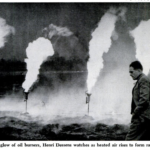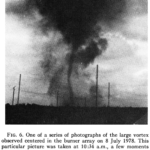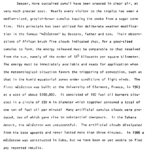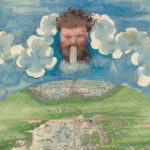All throughout Auvergne, wizards have maintained their ancient reputation, commanding winds and storms as they did in the past…
– Lambert-Élisabeth d’Aubert, count of Résie
From at least the 1600s to the nineteenth century, popular tradition held that the puy de Dôme volcano in Auvergne was the airy domain of witches and wizards — diabolically talented spell-casters who could freely bend the elements to their will and conjure up tornadoes and hailstorms. These beliefs apparently had very real consequences. Writing in 1830, the Auvergnat politician and naturalist, François Dominique de Reynaud, Count of Montlosier, claimed that two hundred angry villagers had once tried to raze his mountainside chateau. Targeted, he maintained, for his supposedly sorcerous ways, the Count was saved only when a storm — either serendipitously or by design — rolled in at the last second, forcing the crowd to turn around and flee.
Interestingly, the puy de Dôme continued to be associated with weather wizardry 125 years after Montlosier’s death. In the 1960s, the Observatoire du puy de Dôme (known today as the Observatoire de physique du globe de Clermont-Ferrand) started backing a series of scientific projects to study “artificial weather modification”. It didn’t take long for things to take a turn for the surreal. In 1963, Henri Dessens, the Observatory’s director and resident Dr Frankenstein, unveiled his own tornado-raising monster: the Météotron.

According to a 1972 US Department of Commerce memo, the Météotron, which consumed one ton of fuel oil per minute, consisted of “100 fuel oil burners situated in a circle of 250 metres in diameter”. Dessens conducted his experiments on the Lannemezan Plateau in the Hautes-Pyrénées, five hours southwest of Clermont-Ferrand. His initial goal was to create cumulus clouds, but to his surprise, he discovered that his invention had the capability, not only to draw down rain from the heavens, but also to whip up powerful, skyscraper-sized tornadoes. The New Scientist reported that one of these whirlwinds appeared six minutes after the burners were turned off and was “about 30 or 40 ft across and 600-700 ft high”.

These kinds of results led some journalists to describe Dessens’s wizardly invention with an optimism that bordered on idealism. In an article published in the August 1964 edition of Popular Science, one writer speculated that the Météotron’s “unleashed power” would be able to — among other things — control hailstorms, clear up air pollution, and dissipate radioactive fallout. The reality, however, was that the Météotron did not always work as expected. It was also too costly to maintain. Still, Dessens’s Météotrons, which were developed further in the 1970s by his son Jean, did catch the attention of the Soviet Union, whose scientists altered the original designs by adding jet engines.
Despite both its promise and its seemingly extraordinary abilities, the Météotron eventually fell into disuse and faded from public memory. Conceived in Auvergne, it ultimately had a fate not dissimilar to the region’s legendary wizards and witches, the weird ways and exploits of whom were swallowed up and forgotten by the ever-shifting sands of time.
To receive more information on Hidden Auvergne — sign up for our newsletter below!








